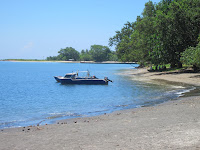 After a return from one of my trips to another village, I found my host family diligently cleaning our area by the ocean. Vanuatu seems to constantly going through both Spring and Autumn at the same time and leaves are always falling. Still, when you visit the villages you won't see much debris about. That little house is a shed my host papa built to hold bags of dried copra until the copra ship comes. The family and any visitors will sometimes gather down here on hot afternoons, especially on Saturdays after church, to enjoy the breeze coming off the ocean.
After a return from one of my trips to another village, I found my host family diligently cleaning our area by the ocean. Vanuatu seems to constantly going through both Spring and Autumn at the same time and leaves are always falling. Still, when you visit the villages you won't see much debris about. That little house is a shed my host papa built to hold bags of dried copra until the copra ship comes. The family and any visitors will sometimes gather down here on hot afternoons, especially on Saturdays after church, to enjoy the breeze coming off the ocean.
My host sister Malonie is busy working.

Meanwhile, a fisherman is cameoing by. There is a taboo on the reef in the bay by my village so fishermen have to paddle to the ocean outside of the reef to catch fish. I've heard that the ban may be lifted soon so we can fish the reef again. "Blocking" a reef or an area for conservation purposes or for some other reason is common.
 This is the road just North of my village. Notice the giant banyan/nambanga tree on the right. The road is pretty good during the dry season and my island even has a few trucks.
This is the road just North of my village. Notice the giant banyan/nambanga tree on the right. The road is pretty good during the dry season and my island even has a few trucks. Visitors to Epi can stay at the Paradise Bangalow (sic) in Laman Bay, one of the bigger businesses on the island.
Visitors to Epi can stay at the Paradise Bangalow (sic) in Laman Bay, one of the bigger businesses on the island.Laman Bay has a long stretch of black sand beach. People from Laman Island come over almost every day on boats like this one to tend to gardens on the "mainland". A few still make the journey by canoe.
 I think that's Ambrym on the left and Lopevi on the right as seen from Nikaura village in North Epi. Ambrym is the much bigger of the two islands, but is further away. At night if the Ambrym volcano is active you can see a red glare above the island.
I think that's Ambrym on the left and Lopevi on the right as seen from Nikaura village in North Epi. Ambrym is the much bigger of the two islands, but is further away. At night if the Ambrym volcano is active you can see a red glare above the island.This is the Rovo Bay market house. Market day is every other Friday and is one of the bigger events on the island. Trucks come and go with produce as well as sellers and buyers. I hang out for most of the day and people know they can find me there to ask questions or talk about projects.

This is Papa Daniel coming back from the garden with a watermelon and a pineapple. Not to brag, but you just haven't had a pineapple until you've had a Papa Daniel pineapple.
Papa Daniel here is my host Papa on Epi. He's also my friend and a very good man. He and Mama Susan are wonderful people and I'm grateful I get to spend two years with them.
-- Daniel --




























